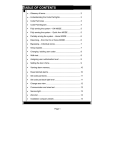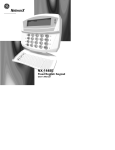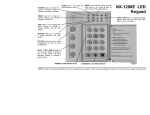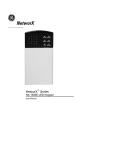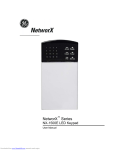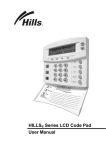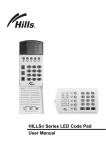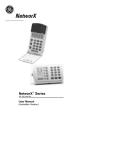Download NX4 User Manual - SA Security Monitoring
Transcript
SECURITY SYSTEM NOTES Installing/Service Company ___________________________________________ For Service Call_____________________ Installation Date / / Central Station__________________________________________ Duress Code_______________________ EMERGENCY ACTIVATION KEYS (check if enabled) q Fire q Auxiliary Emergency q Police PROGRAMMED FUNCTIONS q Auto Arming q Forced Arming q Quick Arm q Chime q Group Bypass q Re-Exit q Communicator Test q Partial Arm q Uni Arm q Fire Alarm Verification ENTRY / EXIT DELAY TIMES Exit Delay Time _________ Secondary Exit Delay Time ________ Entry Delay Time ______________ Secondary Entry Delay Time _______ Partial Delay Time ____________ ZONE DESCRIPTIONS 01 ________________________ 05 ________________________ 02 ________________________ 06 ________________________ 03 ________________________ 07 ________________________ 04 ________________________ 08 ________________________ 1 THIS MANUAL IS PROVIDED TO HELP YOU UNDERSTAND YOUR SECURITY SYSTEM AND BECOME PROFICIENT IN ITS OPERATION. ALL USERS OF YOUR SECURITY SYSTEM SHOULD READ AND FOLLOW THE INSTRUCTIONS AND PRECAUTIONS IN THIS BOOKLET. FAILURE TO DO SO COULD RESULT IN THE SECURITY SYSTEM NOT WORKING PROPERLY. THIS BOOKLET SHOULD BE KEPT IN AN ACCESSIBLE LOCATION FOR THE LIFE OF THE SECURITY SYSTEM. IF YOU DO NOT UNDERSTAND ANY PART OF THIS MANUAL YOU SHOULD NOTIFY YOUR INSTALLING COMPANY. The SECURITY CONTROL can be turned on (ARMED) and off (DISARMED) by entering a 4 or 6 digit code into the Code Pad Control, which is similar to a telephone Code Pad. If your Security Control has been so programmed, you may be able to turn on (ARM) your System by simply pressing the [ON] or [PARTIAL] key. The system should always be disarmed using a 4 or 6 digit code. The LED Code Pad includes up to 35 lights and a built-in electronic sounder. These provide specific information relating to the status of the security system which is described in the booklet. Understanding what the lights and sounds mean will help you to easily operate your system. READ THE ENTIRE MANUAL AND, IF POSSIBLE, PRACTICE ON THE CODE PAD CONTROL WHILE YOUR PROFESSIONAL INSTALLER IS ON SITE. KEEP IN MIND, THE LEVEL OF SECURITY YOU WILL OBTAIN WITH THIS SYSTEM RELATES SPECIFICALLY TO THE FOLLOWING MAJOR FACTORS: 1. The quantity, quality, and placement of security devices attached to this system. 2. The knowledge you have of the security system and how that knowledge is utilized in a weekly test of the complete system. YOU SHOULD BE AWARE OF THE FOLLOWING FACTS WHEN PREPARING A SAFETY/SECURITY PLAN FOR YOUR HOME/BUSINESS. 1. Your security system is an electronic device and is subject to failure or malfunction. Do not rely on it as your single source of security. 2. Your system should be tested weekly. 3. Your system will not work without power. 4. Warning devices will need to be loud enough, wired correctly, and properly placed to provide notification of an alarm event. 5. Smoke and heat detectors may not detect heat and smoke in all situations. 6. Use qualified security professionals to install and maintain your security system. 7. It may be possible to arm the security system without the backup battery connected. Your periodic test should be done with A.C. Power removed to verify the battery is connected and adequately charged. 8. Care should be taken to plug in and restrain the A.C. Transformer after testing. PLEASE READ THE FOLLOWING INFORMATION AND INSTRUCTIONS CAREFULLY BEFORE OPERATING YOUR SECURITY CONTROL SYSTEM. IF YOU DO NOT UNDERSTAND ANY PORTION OF THIS MANUAL, OR IF YOU HAVE ANY QUESTIONS ABOUT YOUR SYSTEM, CONTACT THE INSTALLING COMPANY LISTED ON PAGE 1 OF THIS BOOKLET. 2 TABLE OF CONTENTS GLOSSARY OF TERMS . . . . . . . . . . . . . . . . . . . . . . . . . . . . . . . . . . . . . . . . . . . . . . . . . 4 Abort Delay . . . . . . . . . . . . . . . . . . . . . . . . . . . . . . . . . . . . . . . . . . . . . . . . . . . . . . . . . Authority Level . . . . . . . . . . . . . . . . . . . . . . . . . . . . . . . . . . . . . . . . . . . . . . . . . . . . . . Central Station . . . . . . . . . . . . . . . . . . . . . . . . . . . . . . . . . . . . . . . . . . . . . . . . . . . . . . . Chime . . . . . . . . . . . . . . . . . . . . . . . . . . . . . . . . . . . . . . . . . . . . . . . . . . . . . . . . . . . . . . Codes ............................................................ Duress Code . . . . . . . . . . . . . . . . . . . . . . . . . . . . . . . . . . . . . . . . . . . . . . . . . . . . . . . Forced Arming . . . . . . . . . . . . . . . . . . . . . . . . . . . . . . . . . . . . . . . . . . . . . . . . . . . . . . Function Code . . . . . . . . . . . . . . . . . . . . . . . . . . . . . . . . . . . . . . . . . . . . . . . . . . . . . . . Group Bypass . . . . . . . . . . . . . . . . . . . . . . . . . . . . . . . . . . . . . . . . . . . . . . . . . . . . . . . Master Code ....................................................... Partial Arm . . . . . . . . . . . . . . . . . . . . . . . . . . . . . . . . . . . . . . . . . . . . . . . . . . . . . . . . . . Perimeter . . . . . . . . . . . . . . . . . . . . . . . . . . . . . . . . . . . . . . . . . . . . . . . . . . . . . . . . . . Quick Arm ........................................................ User Code ........................................................ 4 4 4 4 4 4 4 4 4 4 4 4 4 4 UNDERSTANDING THE LIGHTS ........................................ Armed Light . . . . . . . . . . . . . . . . . . . . . . . . . . . . . . . . . . . . . . . . . . . . . . . . . . . . . . . . Bypass Light . . . . . . . . . . . . . . . . . . . . . . . . . . . . . . . . . . . . . . . . . . . . . . . . . . . . . . . . Chime Light . . . . . . . . . . . . . . . . . . . . . . . . . . . . . . . . . . . . . . . . . . . . . . . . . . . . . . . . Exit Light . . . . . . . . . . . . . . . . . . . . . . . . . . . . . . . . . . . . . . . . . . . . . . . . . . . . . . . . . . Fire Light ......................................................... On Light . . . . . . . . . . . . . . . . . . . . . . . . . . . . . . . . . . . . . . . . . . . . . . . . . . . . . . . . . . . . Partial Light . . . . . . . . . . . . . . . . . . . . . . . . . . . . . . . . . . . . . . . . . . . . . . . . . . . . . . . . . Power Light . . . . . . . . . . . . . . . . . . . . . . . . . . . . . . . . . . . . . . . . . . . . . . . . . . . . . . . . Ready Light . . . . . . . . . . . . . . . . . . . . . . . . . . . . . . . . . . . . . . . . . . . . . . . . . . . . . . . . Zone Light ........................................................ 5 5 5 5 5 5 5 5 5 5 5 SERVICE MENU ......................................................6 EMERGENCY ACTIVATION KEYS . . . . . . . . . . . . . . . . . . . . . . . . . . . . . . . . . . . . . . . . . 7 CODE PAD FUNCTIONS . . . . . . . . . . . . . . . . . . . . . . . . . . . . . . . . . . . . . . . . . . . . . . . . Arming in the "On" Mode . . . . . . . . . . . . . . . . . . . . . . . . . . . . . . . . . . . . . . . . . . . . . . Arming System in "Partial" Mode . . . . . . . . . . . . . . . . . . . . . . . . . . . . . . . . . . . . . . . . . Using the Quick Arm . . . . . . . . . . . . . . . . . . . . . . . . . . . . . . . . . . . . . . . . . . . . . . . . . . Disarming the System . . . . . . . . . . . . . . . . . . . . . . . . . . . . . . . . . . . . . . . . . . . . . . . . Bypassing . . . . . . . . . . . . . . . . . . . . . . . . . . . . . . . . . . . . . . . . . . . . . . . . . . . . . . . . . . Un-bypassing ..................................................... Group Bypass . . . . . . . . . . . . . . . . . . . . . . . . . . . . . . . . . . . . . . . . . . . . . . . . . . . . . . Turning the Door Chime On and Off . . . . . . . . . . . . . . . . . . . . . . . . . . . . . . . . . . . . . 7 7 8 8 8 8 9 9 9 CHANGING CODES . . . . . . . . . . . . . . . . . . . . . . . . . . . . . . . . . . . . . . . . . . . . . . . . . . . 9 ASSIGNING USER CODE AUTHORITY . . . . . . . . . . . . . . . . . . . . . . . . . . . . . . . . . . . . 9 OTHER CODE PAD FUNCTIONS . . . . . . . . . . . . . . . . . . . . . . . . . . . . . . . . . . . . . . . . View Alarm Memory ............................................... Reset Smoke Detectors . . . . . . . . . . . . . . . . . . . . . . . . . . . . . . . . . . . . . . . . . . . . . Managing Phone Numbers . . . . . . . . . . . . . . . . . . . . . . . . . . . . . . . . . . . . . . . . . . . . Communicator Test Function . . . . . . . . . . . . . . . . . . . . . . . . . . . . . . . . . . . . . . . . . . Set System Date . . . . . . . . . . . . . . . . . . . . . . . . . . . . . . . . . . . . . . . . . . . . . . . . . . . . Set System Clock . . . . . . . . . . . . . . . . . . . . . . . . . . . . . . . . . . . . . . . . . . . . . . . . . . Set Code Pad Tone . . . . . . . . . . . . . . . . . . . . . . . . . . . . . . . . . . . . . . . . . . . . . . . . . Code Pad Control Tones . . . . . . . . . . . . . . . . . . . . . . . . . . . . . . . . . . . . . . . . . . . . . Emergency Evacuation Plan . . . . . . . . . . . . . . . . . . . . . . . . . . . . . . . . . . . . . . . . . . 3 10 10 10 12 12 13 13 13 14 15 GLOSSARY OF TERMS Abort Delay: An option that allows a delay in reporting to the central station. Authority Level: The level of access an individual has when using an alarm panel. Central Station: Location where alarm data is sent during an alarm report. Chime Feature: An option that allows the code pad to sound a ding-dong whenever an entry/exit door is opened. Codes: Can be either User Codes (relating to a person) or Function Codes (a toggle switch to turn specific functions on/off). NOTE: A system may have a maximum of eight 4digit codes or eight 6- digit codes, but not a mixture of both. Duress Code: An option that allows a special code to be sent to the central station that indicates the alarm system is being operated under duress. Forced Arming: An option that allows the system to be turned on (ARMED) with one or more zones open. A system that is ready to be “force armed” will flash the ready light. (Note: Those zones that are not ready will not create an alarm.) Function Code: A Function Code is either a four (4) or six (6) digit code that has been programmed by the installer to operate a device. Group Bypass: An option that allows the user to bypass multiple zones with a single operation. Master Code: A master arm/disarm code that can program other user codes. Partial Arm: A mode used to arm the perimeter and unused areas of an occupied premises. Perimeter: The outer edge of the protected area. Quick Arm: An option that allows you to turn on (ARM) the security system by pressing either the [ON] or [PARTIAL] key on the code pad control (for ARMING only) as programmed by the installing company. Universal Arming (Uni Arm): When enabled, your alarm system can automatically determine whether to arm in the Full mode or in the preset Partial mode by looking to see if you exit your premises or stay inside after arming your system. NOTE: This feature can be used in conjunction with “Quick Arm”. User Code: A four (4) or six (6) digit entry used to arm or disarm the system. 4 UNDERSTANDING THE LIGHTS Armed Light The armed light is “on” when the system is armed. The armed light is “off” when it is disarmed. The armed light will flash when there has been an alarm during the previous arm cycle. Bypass Light The bypass light is “on” when any zone is bypassed. The zone(s) that is bypassed will also be illuminated. If the bypass light is “off”, no zones are bypassed. Chime Light The chime light is “on” when the chime feature is “on”; “off” otherwise. Exit Light The exit light is “on” during the exit delay. Please note that the light will flash during the last 10 seconds of the exit delay as a warning that the time is running out. (The user may want to restart the exit delay if the exit light is flashing in order to prevent an alarm. The user may then press the [Exit] key to restart the exit delay before the delay expires.) Fire Light A steady fire light means a fire zone has been faulted. A rapidly flashing fire light means that a fire zone is in a trouble condition. On Light The on light is “on” when the system is armed. The on light is “off” when it is disarmed. Partial Light The partial light is “on” when the system is armed in the Partial Mode. All non bypassed zones will be delayed and follow the Partial delay time. When armed in Partial Mode, the Arm, On, and Bypass lights will also be “on”. Power Light The power light is on if the primary power is on. The power light will flash if the system has a low battery condition. Ready Light The ready light is “on” when the system is ready to arm and “flashes” if ready to force arm. The ready light is off when the system is not ready to arm because of a zone(s) being faulted. Zone Light The zone lights are “off” when everything is normal. A zone light will be “on” if the zone has been bypassed. If a zone light is “flashing”, that zone is in alarm or has been faulted. If a zone light is “flashing” rapidly, it means that the zone is in a trouble condition. Trouble conditions are: Tamper Hardware Wireless Sensor Wireless Sensor Low Battery Loss of Supervision (A combination of Alarm/Fault and Tamper/Trouble will produce a rapid “flashing” light for a short period of time, followed by a slow “flashing” light.) 5 SERVICE MENU The service light will be “on” if the security system requires service. If the service light is “on”, press the [ r] key followed by the [2] key to determine the service condition. One or more zone lights will illuminate indicating what service(s) is required. Call your service provider immediately for these problems. Below is a listing of what each light means in a service condition. LIGHT PROBLEM 1 SYSTEM FAULT - Press the [1] key. The zone light(s) that is illuminated corresponds to the system fault(s) below: 1 2 3 4 Over Current Fault Siren Trouble Box Tamper Expander Power 5 6 7 8 Expander Low Battery Expander Box Tamper Expander Trouble Reserved Press the [#] key to return to the 1 of 8 service lights. 2 ZONE TAMPER - Press the [2] key and the zone light(s) will illuminate showing the zone(s) that is tampered. Press the [#] key to return to the 1 of 8 service lights. 3 ZONE LOW BATTERY - Press the [3] key. The zone light(s) will illuminate showing which zone(s) has a low battery. This only applies to wireless zones. Press the [#] key to return to the 1 of 8 service lights. 4 ZONE LOSS OF SUPERVISION - Press the [4] key and the zone light(s) will illuminate showing which zone(s) has loss of supervision. This only applies to wireless zones. Press [#] key to return to the 1 of 8 service lights. 5 ZONE TROUBLE - Press the [5] key and the zone light(s) will illuminate showing which zone(s) has a trouble condition. Press the [#] key to return to the 1 of 8 service lights. 6 RESERVED 7 FAILURE TO COMMUNICATE - This light will illuminate when there is a failure to communicate between your system and the central station. 8 LOSS OF SYSTEM TIME - This light will illuminate when there has been a loss of power and your system clock needs to be reset. Instructions are on page 13. Exit To exit the Service Light Mode - press the [#] key. 6 EMERGENCY ACTIVATION KEYS NOTE: You must hold these keys for 2 seconds to activate these functions. Your system may not be programmed for these activation keys (see page 1). You should press these keys only in an emergency situation that requires response by emergency personnel. If your system is programmed for these functions, the following reports can be sent. Fire Key – This key can activate the fire alarm when pressed for two seconds. If your system is connected to a monitoring centre, an emergency report could be sent to that centre. Auxiliary Emergency Key – This key can activate the auxiliary alarm when pressed for two seconds. If your system is connected to a monitoring centre, an emergency report could be sent to that centre. Police (Panic/Hold-Up) Key - This key can sound a local audible alarm when pressed for two seconds. If your system is connected to a monitoring centre, an emergency report could be transmitted to that centre. NOTE: Some Panic/Hold-Up alarms are programmed to be silent at the protected site while reporting an alarm to the monitoring centre. Check with your installation company to determine how your security system will respond to the Panic/Hold-Up activation. 7 CODE PAD FUNCTIONS ARMING YOUR SYSTEM IN THE “ON” MODE. ON is used when the user is away from the premise and wants the interior protected. Listed below are the steps to arm in the ON Mode: Step 1 Close all protected doors and windows. Ready light will be on or flashing when all protected zones and sensors are secure. NOTE: If any zones are bypassed, a sensor in that zone can be violated without affecting the ready light. The security system will not arm if the ready light is not on or flashing. If the power light is off, you have no AC power. Restore power if possible. If not, contact your installation company listed on page 1 of this booklet for service. Step 2 Enter your 4 or 6 digit user code to arm the system. The armed and exit lights will illuminate. You may now leave the building. Note: The exit light will flash rapidly for the last 10 seconds of the exit delay as a warning to the user that the exit time is about to expire. The user may wish to press the [Exit] key to start the exit delay again or disarm and rearm the system if more time is needed. ARMING SYSTEM IN “PARTIAL” MODE PARTIAL is used when the user is inside the premise and wants protection around the perimeter. Listed below are the steps to arm in the PARTIAL Mode: Step 1 Close all protected doors and windows. Ready light must be on or flashing when all protected zones and sensors are secure. NOTE: If any zones are bypassed, a sensor in that zone can be violated without affecting the ready light. The security system will not arm if the ready light is not on or flashing. If the power light is off, you have no AC power. Restore power if possible. If not, contact your installation company listed on page 1 of this booklet for service. Step 2 Press the [Partial] key. The bypass light will illuminate if any zone(s) is bypassed. The light(s) corresponding to the bypassed zone(s) will illuminate, alerting the user that a zone(s) may be unprotected and can be faulted without an alarm. USING THE QUICK ARM (Optional, if programmed, see page 1.) The Quick Arm feature may be used if it is enabled. Quick Arm will allow the user to arm the security system in the ON mode by pressing the [ON] key. The system can be quick armed in the Partial mode by pressing the [PARTIAL] key. This feature is used for ARMING ONLY, and should not be enabled to disarm the security system. This is ideal for a maid or baby sitter code, etc. DISARMING THE SYSTEM When you enter the protected area through one of the designated Entry/Exit doors, the code pad control will sound a solid continuous tone for the duration of the entry delay time, or until you enter a valid code. After entering a valid code the red armed light will go off and 8 the tone will stop. The security system is now DISARMED. If a valid code is not entered before the end of the entry delay, an alarm will occur. (NOTE: If the red armed light is flashing during the entry delay, the alarm system has been activated in your absence. Leave the building immediately and call your alarm company and/or the police from a safe location.) BYPASSING ZONES If you wish to bypass one or more zones, this must be done while the system is in the disarmed state. The following steps are used for bypassing zones: Step 1 Press the [BYPASS] key. Step 2 If required (optional), enter user code, if required (optional). Step 3 The bypass light flashes. Step 4 Enter a 2 digit zone indicating the zone you wish to bypass. (Example: Press the [0]- [1] key for zone 1, press [1] - [2] for zone 12.) Step 5 Press the [BYPASS] key again. Step 6 The corresponding zone light will illuminate indicating the zone has been bypassed. Repeat 4 for any other zone(s) that need to be bypassed. Step 7 Press the [BYPASS] key again or press the [#] key to exit the Bypass Mode. The Bypass light will stop flashing upon exiting the Bypass Mode. UN-BYPASSING To manually un-bypass zones, perform the bypassing procedure on a zone that is already bypassed. The corresponding light for that zone will go off when un-bypassed. NOTE: All zones will automatically be un-bypassed each time the system is disarmed. GROUP BYPASS By pressing the [BYPASS] key, followed by the [0][0] key, then the [BYPASS] key again, all zones that are designated as group bypass zones will be bypassed. Now you can arm your system in either the [ON] or [PARTIAL] mode. Once armed (and the bypass toggle feature is enabled) press the [BYPASS] key again to exit group bypassing. TURNING THE DOOR CHIME ON AND OFF The door chime is turned on or off by pressing the [CHIME] key while the system is in the disarmed state. If the chime is on, the chime light will be illuminated. If the chime is off, the chime light will be off. Each press of the [CHIME] key will toggle the chime feature on/off and produce a momentary ding-dong sound. 9 CHANGING USER CODES Step 1 Your system must be in the Disarmed state to change user codes. Step 2 Press the [r r] [5] keys. Step 3 Enter a “Master Arm/Disarm Code”. Step 4 The ready light will flash. Step 5 Enter the 2 digit “user number” (always enter 2 digit such as [0]-[3] for user 3, or [5]-[2] for user 52). Step 6 Enter the new four (4) or six (6) digit “user code”. Note: To delete a user code, enter [Chime]-[Chime]-[Chime]-[Chime] for a 4-digit code, or [Chime]-[Chime][Chime]-[Chime]-[Chime]-[Chime] for a 6-digit code. Step 7 The ready light will flash indicating you are back at Step 5 above. If the code is rejected, the sounder will beep 3 times. Step 8 If another “user code” needs to be programmed, return to Step 6. Step 9 Press the [#] key while the ready light is flashing to exit the User Code Programming Mode. ASSIGNING USER CODE AUTHORITY LEVELS Assign authority levels to users by following the steps below. Assign user codes before assigning authority levels. Step 1 Press the [r][6] keys. Step 2 Enter a “Master Arm/Disarm Code”. NOTE: Someone changing the authority of another person can only add or remove authorization if they have access to that same authority level. Step 3 The ready light will flash. Step 4 Enter the 2 digit “user number” to be assigned authority (The ready light is constant and the partial light will flash). Step 5 Lights illuminated indicate the authority levels assigned to this code. An explanation of the lights is listed below. You may toggle (turn on/off) the authority level by pressing the number for that authority level. LIGHT AUTHORITY LEVELS IF LIGHT 8 IS OFF LIGHT AUTHORITY LEVELS IF LIGHT 8 IS OFF 1 Reserved (Note: Do not change if on.) 5 Arm/Disarm 2 Arm Only 6 Bypass Zones 3 Arm Only After Close Window 7 Open / Close Reporting 4 Master Arm/Disarm (can program other codes) 8 If this light is on, Press [#] [#] to exit. Step 6 Press the [r r][r r]. This returns you to Step 3. At this point you may enter another user number to assign authority level. Repeat Steps 4 - 6 until you have assigned authority levels to all user numbers. Step 7 Press the [#] key to exit the Assigning Authority Level Program. 10 VIEW ALARM MEMORY Step 1 Press the [r r] key. Step 2 Press the [3] key. Step 3 The ALARM MEMORY feature will flash those zones that created alarms and will light steady those zones that were bypassed during the last alarm. RESET SMOKE DETECTORS This function is used to reset Smoke Detectors, Zone Troubles, and Zone Tampers. Step 1 Disarm the system if not disarmed. Step 2 Press the [r r] key. Step 3 Press the [7] key. Reset has now been performed. Step 4 If the code pad begins beeping, the reset did not execute properly. Enter your code to silence the code pad. Wait a few minutes and repeat step 2 to attempt another reset. If the code pad still beeps after repeated attempts, please contact your installer. 11 USER PROGRAMMABLE TELEPHONE NUMBERS When pager or siren tone formats are selected, any of the three phone numbers may be programmed or altered in the run mode. You must use the following procedure to enter the phone numbers. Step 1 Press the [r r] key. Step 2.a Press the [4]-[1] key. (For phone number one (1) ) Step 2.b Press the [4]-[2] key. (For phone number two (2) ) Step 2.c Press the [4]-[3] key. (For phone number three (3) ) Step 3 Enter a “Master Arm/Disarm Code”. Step 4 Now enter the required number, not exceeding 20 digits. Use the following table to determine Key values. Key Phone Digit Key Phone Digit [1] 1 [9] 9 [2] 2 [0] 0 [3] 3 [ON] Star (r) [4] 4 [PARTIAL] Pound (#) [5] 5 [EXIT] 4 Sec Delay [6] 6 [BYPASS] Disable [7] 7 [CHIME] Pulse Dialing [8] 8 Step 5 Press [#] to end and exit. VIEWING TELEPHONE NUMBERS When pager or siren tone formats are selected, any of the three phone numbers may be viewed in the run mode. You must use the following procedure to view the phone numbers. Step 1 Press the [r] key. Step 2.a Press the [4]-[1] key. (For phone number one (1) ) Step 2.b Press the [4]-[2] key. (For phone number two (2) ) Step 2.c Press the [4]-[3] key. (For phone number three (3) ) Step 3 Enter a “Master Arm/Disarm Code”. Now you are in the view mode and the first phone digit will be displayed. Use the following table to read the code pad lights. Go to step 4 to view the rest of the phone number. Step 4 Press the [r] key to move to the next digit. 12 Use the following table to determine Key values. Light Phone Digit Light Phone Digit [Zone 1] 1 [Zone 10] 0 [Zone 2] 2 [FIRE] 9 [Zone 3] 3 [SERVICE] 0 [Zone 4] 4 [ON] Star (r) [Zone 5] 5 [PARTIAL] Pound (#) [Zone 6] 6 [EXIT] 4 Sec Delay [Zone 7] 7 [BYPASS] Disable [Zone 8] 8 [CHIME] Pulse Dialing [Zone 9] 9 Step 5 Press [#] to end and exit. DELETING TELEPHONE NUMBERS When pager or siren tone formats are selected, any of the three phone numbers may be deleted in the run mode. You must use the following procedure to delete the phone numbers. Step 1 Press the [r r] key. Step 2.a Press the [4]-[1] key. (For phone number one (1) ) Step 2.b Press the [4]-[2] key. (For phone number two (2) ) Step 2.c Press the [4]-[3] key. (For phone number three (3) ) Step 3 Enter a “Master Arm/Disarm Code”. Step 4 Press the [BYPASS] key. Step 5 Press [#] to end and exit. TEST FUNCTION – Optional If programmed, this function will perform a battery test, communicator test, and a siren test. No alarms will be sent, and no reports will be sent unless the communicator test is enabled. Step 1 Press the [r r] key. Step 2 Press the [4]-[4] key. The test will be performed as programmed. Step 3 If the siren test is performed, enter a user code to silence the siren. No alarms will be sent and no reports will be sent unless a communicator test is performed, at which time a test signal will be sent. 13 SET SYSTEM DATE Step 1 Press the [r r]-[9]-[6]. Step 2 Enter the “Master Code”. Step 3 Enter the “Day of Week “ 1 = Sunday 2 = Monday Step 4 3 = Tuesday 4 = Wednesday 5 = Thursday 6 = Friday 7 = Saturday Enter the “Month Code”. This must always be two (2) digits. 01 = January 02 = February 03 = March 04 = April 05 = May 06 = June 07 = July 08 = August 09 = September 10 = October 11 = November 12 = December Step 5 Enter the “Day Code”. This must always be two (2) digits. Example: The 5th would be entered as [0]–[5]. Step 6 Enter the last two digits of the “Year Code”. Example: For 2000 enter [0]–[0]. SETTING THE SYSTEM CLOCK Step 1 Press the [r r] key . Step 2 Press the [9]-[7] keys. Step 3 Enter the “Master Code “. Step 4 Enter the “hour code” which must be two (2) digits. Note: The clock is a 24 hour clock. Example: 12.00 am would be entered as [0]-[0], 7.00 am would be entered as [0]-[7], and 5.00 pm would be entered as [1]-[7]. Step 5 Enter the “minutes code” which must be two (2) digits. Example: 7 minutes after would be entered [0] – [7]. SETTING CODE PAD TONES Step 1 Press the [r r]-[0] keys. Now the code pad is in the “Adjust Tone “ mode. Step 2 Pressing the [1] key will adjust the code pad sounder to a higher tone. Pressing the [2] key will adjust the code pad sounder to a lower tone. Step 3 When the desired tone is reached, press the [#] key to set this tone and exit the “Adjust Tone” mode. WALK-TEST MODE Step 1 Press [r] [Chime] Step 2 Enter a “Master Arm/Disarm Code”. Now all zones become 24 hour, silent, and local (non-reporting zones). By faulting any zone, that zone will latch its zone light on the LED code pad, and sound the Chime. The Chime will continue to sound each time a zone is faulted. Once all zones are tested (zone lights lit on the LED code pad), go to Step 3. Step 3 Press a “Master Arm/Disarm Code”. 14 CODE PAD CONTROL TONES (BEEPS) 1 Beeps for all keypresses. 2 Sounds a continuous tone during the entry delay time. 3 Pulses when a day zone is violated while the system is disarmed. 4 Pulses when a fire zone has a trouble condition. 5 Beeps 3 times for trying to arm with the “Ready” light off, if “Force Arming” has not been selected. 6 Beeps for 1 second or emits a “ding-dong” sound for the “Chime” feature. 7 Beeps during an exit delay; beeps rapidly for the last 10 seconds of an exit delay; and beeps 1 second at the end of the exit delay. 8 Pulses when the armed status changes and the AC power is off. 9 Pulses when the armed status changes and any zone(s) is bypassed. 10 Pulses when the armed status changes and a low battery is detected. 11 Pulses when the armed status changes and a tamper condition is detected. Beeps to indicate telephone line cut, if selected. 12 Pulses when one or more of the following conditions are detected: zone or box tamper, low battery, ac power fail, or expander trouble. Entering a valid code will silence the code pad sounder when it is pulsing. Please contact your installer if a trouble condition exists. 15 EMERGENCY EVACUATION PLAN An emergency evacuation plan should be established for an actual fire alarm condition. For example, the following steps are recommended by the National Fire Protection Association and can be used as a guide in establishing an evacuation plan for your building. Draw up a floor plan of your home. Show windows, doors, stairs, and rooftops that can be used for escape. Indicate each occupant's escape routes. Always keep these routes free from obstruction. Determine two means of escape from each room. One will be the normal exit from the building. The other may be a window that opens easily. An escape ladder may have to be located near the window if there is a long drop to the ground below. Set a meeting place outdoors for a headcount of the building occupants. Practice escape procedures. In a home, sleep with bedroom door closed; this will increase your escape time. If you suspect fire, test the door for heat. If you think it is safe, brace your shoulder against the door and open it cautiously. Be ready to slam the door if smoke or heat rush in. Practice escaping to the outdoors and meeting in an assigned spot. Call the Fire Department from a neighbour's phone. Early warning fire detection is best achieved by the installation of fire detection equipment in all rooms. 16 FOR SERVICE, CONTACT: NX4 LED CODE PAD NX4DASUA98 REV A (7-31-98)

















